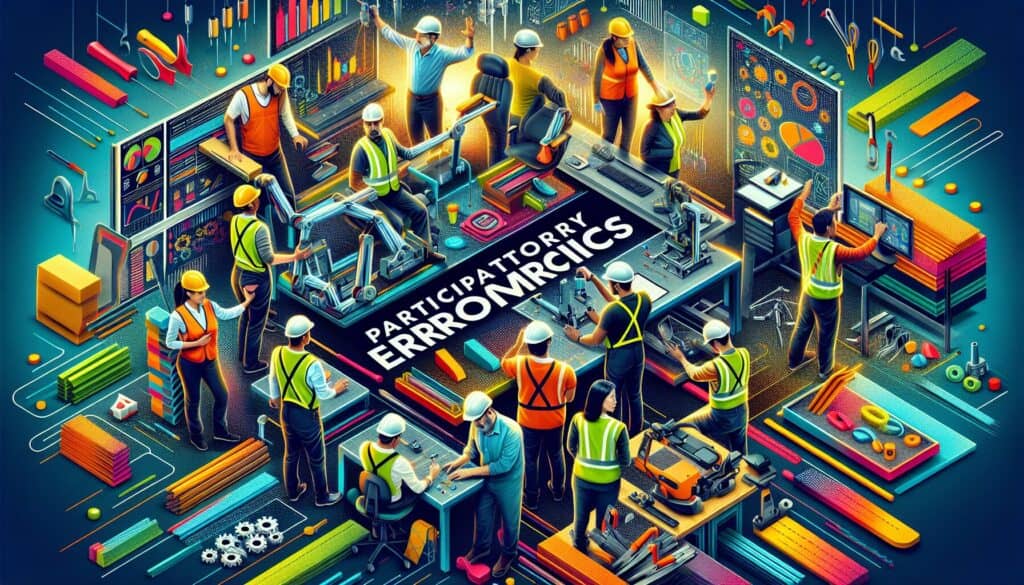Impliquer activement les travailleurs dans l'identification, l'analyse et le contrôle ergonomique les risques liés à leur emploi et à leur environnement de travail.
- Méthodologies : Ingénierie, Qualité
Ergonomie participative (impliquant la participation des travailleurs)

Ergonomie participative (impliquant la participation des travailleurs)
- Amélioration continue, Ergonomie, Facteurs humains, Conception centrée sur l'humain, Production allégée, Techniques de résolution de problèmes, Amélioration des processus, Travail d'équipe, User-Centered Design
Objectif :
Comment il est utilisé :
- Forme des équipes composées de travailleurs, de superviseurs et d'experts en ergonomie afin d'identifier collectivement les problèmes ergonomiques, de réfléchir à des solutions et de mettre en œuvre et d'évaluer les améliorations.
Avantages
- Augmente l'adhésion et l'appropriation des solutions par les travailleurs ; utilise la connaissance directe qu'ont les travailleurs de leurs tâches ; conduit souvent à des solutions plus pratiques et plus durables.
Inconvénients
- La gestion du processus participatif peut prendre beaucoup de temps ; elle nécessite une formation pour les travailleurs et la direction ; elle peut donner lieu à des opinions contradictoires ou à des suggestions irréalistes si elle n'est pas bien animée.
Catégories :
- Ergonomie, Fabrication, Qualité
Idéal pour :
- Impliquer directement les employés dans le processus d'identification et de résolution des problèmes ergonomiques sur leur lieu de travail.
Participatory Ergonomics is particularly beneficial in sectors such as manufacturing, healthcare, and office environments, where physical tasks and workspace layouts significantly impact worker safety and productivity. During the design phase of a new workspace or equipment, this methodology can be implemented effectively through workshops and brainstorming sessions involving a diverse team of employees who perform the tasks, supervisors who manage workflows, and ergonomics experts who understand the principles of optimal design. The collaboration among these participants not only allows for a comprehensive identification of ergonomic challenges but also encourages innovative solutions grounded in real-world applications. Various industries have successfully adopted this approach to enhance job satisfaction and productivity while reducing workplace injuries; for example, in manufacturing, workers can provide feedback on machinery layouts and tool accessibility, while in healthcare, nursing staff can identify challenges in lifting techniques or equipment placement that affects patient care. Engaging employees in this manner fosters a culture of continuous improvement as they become invested in the solutions they help create, making it more likely that changes will be implemented effectively and maintained over time. When teams regularly evaluate the changes made and solicit further input, an ongoing dialogue is established, promoting adaptability as tasks and technologies evolve. The success of these initiatives often leads organizations to establish permanent ergonomic committees or task forces that regularly assess workplace conditions and champion employee-driven improvements.
Principales étapes de cette méthodologie
- Identify ergonomic issues through interactive discussions with workers.
- Engage in brainstorming sessions to generate ideas for improvements.
- Prioritize identified solutions based on feasibility and impact.
- Develop action plans for implementing selected solutions collaboratively.
- Execute the action plans while involving workers in the process.
- Monitor and assess the impact of implemented solutions with worker feedback.
- Iterate on solutions based on evaluation results and ongoing worker input.
Conseils de pro
- Conduct regular workshops that allow workers to voice concerns and suggest feasible ergonomic enhancements, fostering an ongoing dialogue around workplace safety.
- Utilize collaborative tools and visual aids like sketches or 3D models during brainstorming sessions to guide discussions toward tangible solutions.
- Establish metrics for evaluating ergonomic interventions, ensuring feedback loops are in place for continuous improvement based on real-world applications and user experiences.
Lire et comparer plusieurs méthodologies, nous recommandons le
> Référentiel méthodologique étendu <
ainsi que plus de 400 autres méthodologies.
Vos commentaires sur cette méthodologie ou des informations supplémentaires sont les bienvenus sur le site web de la Commission européenne. section des commentaires ci-dessous ↓ , ainsi que toute idée ou lien en rapport avec l'ingénierie.
Contexte historique
1986
(si la date est inconnue ou n'est pas pertinente, par exemple "mécanique des fluides", une estimation arrondie de son émergence notable est fournie)

Articles Similaires
Calculateur de METS en calories
Méta-analyse
Cartographie des messages
Diagrammes du modèle mental
Forces de poussée et de traction maximales acceptables
Planification des besoins en matériaux (MRP)